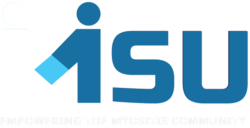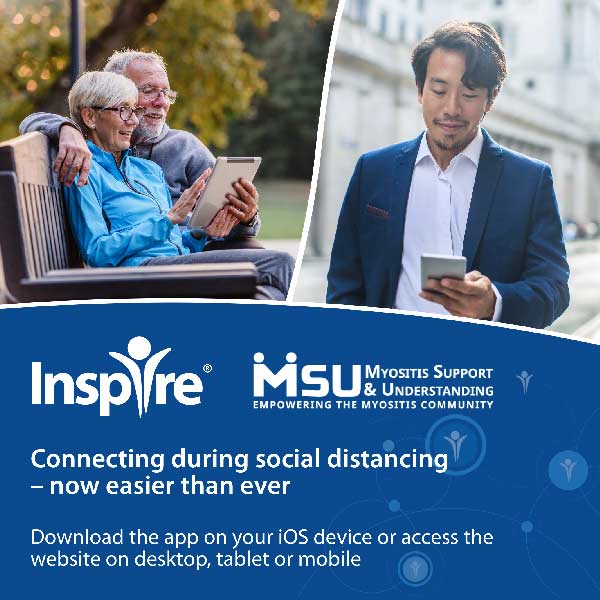IMMUNE-MEDIATED
NECROTIZING MYOPATHY
Immune-mediated necrotizing myopathy (IMNM) is a rare
complement-mediated muscle disease. Muscle cell necrosis
leads to severe muscle weakness, severely impacting
a patient’s quality of life. IMNM is classified into three
subtypes based on autoantibodies anti-HMGCR,
anti-SRP, and antibody (Ab) negative.

SCROLL DOWN
to learn more
CLINICAL TRIAL FOR IMNM
FACTS ABOUT IMNM
IMNM is an incurable and debilitating chronic, rare muscle disease without FDA approved treatments.
Who is affected by Immune-Mediated Necrotizing Myopathy?
Immune-Mediated Necrotizing Myopathy affects
- women and men with an average age of onset between ages 40-60
- children, where it may mimic a muscular dystrophy
- an estimated 21 people per million
- an estimated 6,300 people in the U.S.
How rare is Immune-Mediated Necrotizing Myopathy?
When first described, it was estimated that only 300 cases of IMNM existed in the U.S. However, with commercially accessible antibody testing and research, this number has increased. Many patients were originally diagnosed with polymyositis, and under some criteria used, would still be today.
Is this the same as Necrotizing Autoimmune Myopathy (NAM)?
Yes. Necrotizing Autoimmune Myopathy (NAM) and Immune-Mediated Necrotizing Myopathy (IMNM) refer to the same type of idiopathic inflammatory myopathy. You may also see the new subtypes listed as the name of the disease, such as anti-SRP myopathy, anti-HMGCR myopathy, and antibody-negative IMNM. IMNM is characterized by prominent myofiber necrosis with little or no muscle inflammation.
What causes Immune-Mediated Necrotizing Myopathy?
It is thought that complement, a complex part of the immune system, is activated in those with IMNM. This causes muscle fiber necrosis leading to severe and debilitating muscle weakness with atrophy and fatty replacement, extremely high CK levels, and myalgia (pain).
Are there treatments for IMNM?
There are no FDA approved medications for IMNM, or for any of the idiopathic inflammatory myopathies (IIM). The use of off-label medications, often in combination therapy using various immunosuppressing medications, which have harsh side effects and put patients at risk for infections, are helpful for some, but many patients continue to show progression and incomplete recovery.
Anti-hydroxy-3-methylglutaryl-CoA reductase (HMGCR)
ANTI-HMGCR
Often associated with the use of statins. Patients with no statin medication history tend to be younger with more severe muscle disease (myopathy).
Anti-signal recognition particle (SRP)
ANTI-SRP
Presents with severe muscle disease (myopathy) and disability, and extramuscular involvement. In children, this may mimic a form of muscular dystrophy.
Seronegative IMNM
Ab NEGATIVE
Antibody (Ab) negative IMNM, where no known autoantibody is found, is poorly described and further research is needed. A muscle biopsy is needed for a diagnosis.
IMMUNE-MEDIATED NECROTIZING MYOPATHY WITH DR. ANDREW MAMMEN
Dr. Andrew Mammen joined us for an interesting and engaging discussion about the various forms of myositis with a focus on immune-mediated necrotizing myopathy (IMNM), also referred to as Necrotizing Autoimmune Myopathy (NAM).
IS IT POLYMYOSITIS OR IMMUNE-MEDIATED NECROTIZING MYOPATHY?
In this section of video, Dr. Lisa Christopher-Stine discusses how IMNM is often misdiagnosed as polymyositis. Myositis antibody testing, inflammatory markers, EMG and Nerve Conduction Studies, muscle biopsy, and a thorough medical exam and history can help in making an accurate diagnosis. Watch the entire session, “Polymyositis: The evolution of this diagnosis in light of recent research” here.
Immune-Mediated Necrotizing Myopathy
OVERVIEW
Immune-mediated necrotizing myopathy (IMNM), sometimes called autoimmune necrotizing myopathy (NAM), is a rare complement-mediated muscle disease and is one of the idiopathic inflammatory myopathies (IIM).
Muscle cell necrosis (death) leads to severe muscle weakness, pain, and fatigue, critically impacting a patient’s quality of life.
IMNM is divided into three subtypes based on the presence of autoantibodies, although they share many of the same signs and symptoms, which in many cases appear similar to polymyositis, and may include:
- Symmetric proximal muscle weakness (this means: Experience muscle weakness on each side of the body, like both legs, and the muscles closest to the core being affected, like quadriceps.),
- Often more severe in the lower extremities and neck muscles.
- Highly elevated CK/CPK levels (muscle enzymes), some more than 10 times the normal limit.
- Inability or difficulty climbing stairs, getting into a car, and rising from a seated position, walking, standing, washing, combing or brushing one’s hair, or raising arms to lift an item such as putting a plate in a cabinet.
- Muscle pain (myalgia)
- Falling or tripping
- Dysphagia (trouble swallowing)
- Fatigue, which can be debilitating
- Weight loss
IMNM Subtypes
The European Neuromuscular Centre (ENMC) criteria recognize three distinct subtypes of IMNM using serologic subclassification. Two myositis-specific autoantibodies have helped subcategorize patients; Anti-SRP and Anti-HMGCR, along with a third subclassification of autoantibody-negative (Ab negative) IMNM.
IMNM is characterized by prominent myofiber necrosis (muscle cell death) with little or no muscle inflammation. A diagnosis of IMNM can be confirmed without a muscle biopsy if a patient tests positive for one of the IMNM specific autoantibodies; anti-HMGCR or anti-SRP. However, some physicians and researchers may require a muscle biopsy.
Atrophy and fatty replacement of muscle tissue may occur very quickly after the onset of symptoms. Therefore, obtaining a quick and accurate diagnosis allows a patient to start aggressive immunosuppression therapy that may help prevent long-term functional disability.
These subtypes share many similar characteristics, but they are different diseases and often respond differently to off-label immunosuppressive therapy.
Immune-Mediated Necrotizing Myopathy
ANTI-HMGCR MYOPATHY
The anti-HMGCR autoantibody (3-hydroxy-3-methylglutaryl-coenzyme A reductase), the pharmacologic target of statins, and one of the myositis-specific antibodies is highly specific and is not usually found in healthy people or those with other autoimmune or inflammatory diseases. Patients with genetically proven muscular dystrophy do not have anti-HMGCR autoantibodies.
The presentation of each patient may vary, however, these patients can be grouped into one specific subtype of disease based on shared muscle biopsy features and the presence of anti-HMGCR autoantibodies.
This subtype does not typically have extramuscular involvement and is often limited to skeletal muscle fiber necrosis with little-to-no inflammation leading to muscle weakness. Other symptoms may include dysphagia (trouble swallowing), muscle pain (myalgia), and fatigue.
Some studies suggest there may be an association with malignancy, so cancer screenings are suggested.
Immune-Mediated Necrotizing Myopathy
ANTI-SRP MYOPATHY
Anti-SRP (signal recognition particle) autoantibodies were the first myositis autoantibodies identified as being specifically associated with IMNM. This used to be diagnosed as polymyositis.
Muscle weakness tends to severely affect the lower limbs, and the creatine kinase (CK) levels are extremely elevated. The anti-SRP autoantibody is thought to correlate with CK levels and this may be a good indication of disease activity for some patients.
Extramuscular features may include dysphagia (trouble swallowing) as well as a rare risk of cardiac involvement, including rhythm or conduction abnormalities and cardiac insufficiency. Interstitial lung disease (ILD) may also be present, but it is usually mild. Other associated features may include muscle pain (myalgia) and fatigue.
Muscle weakness associated with anti-SRP myopathy is often severe and disabling and is thought to be one of the most severely disabling autoimmune diseases. Even with treatment, recovery can be poor.
In his research, Allenbach notes that “the outcome of anti-SRP myopathy is poor since only half of patients recover normal strength after four years.”
Immune-Mediated Necrotizing Myopathy
ANTIBODY NEGATIVE MYOPATHY
Ab (antibody) Negative immune-mediated necrotizing myopathy is a subtype where no known associated autoantibody is found circulating in the blood. Muscle biopsies show similar results to those with anti-HMGCR and anti-SRP myopathy, and they share many of the same symptoms including highly-elevated CK levels, myalgia (muscle pain), and fatigue.
This subtype requires a muscle biopsy for diagnosis. Research is ongoing to learn more and to better understand.
Immune-Mediated Necrotizing Myopathy
DIAGNOSING AND TREATING
As with other rare diseases, including other types of myositis, IMNM can be difficult to diagnosis. Patient history, physical exam, Myositis-Specific antibodies (MSA), Myositis-Associated antibodies (MAA), other blood tests (muscle enzymes, inflammatory, autoimmune, and cancer markers, and other antibodies), MRI, EMG, Nerve Conduction, and a muscle biopsy can assist in making a diagnosis.
There is no standard of care or FDA approved medications to treat immune-mediated necrotizing myopathy. Off-label use of medications used in treating IMNM includes the same medications used to treat the other types of autoimmune myositis.
Treatment often requires a combination of medications, and still, many patients do not recover well or gain strength.
Discontinuation of statin medications and avoidance of this class of drugs is typically recommended.
ASK QUESTIONS
Being open, honest, and specific about your symptoms, needs, and goals with your healthcare team is important. Ask questions, follow up for answers, and think about keeping a medical journal.
If your doctor suspects IMNM, the myositis-specific antibody panel may be helpful. Note that the HMGCR antibody is not included in the full panel.






